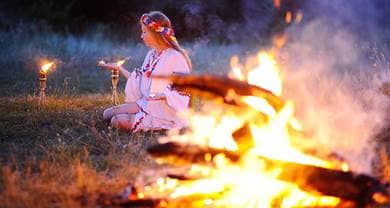- Trending:
- Pope Leo Xiv
- |
- Israel
- |
- Trump
- |
- Social Justice
- |
- Peace
- |
- Love

RELIGION LIBRARY
Paganism
Pagan Symbolism
A visitor to a bookstore or gift shop that caters to Pagans will notice a broad assortment of symbolic jewelry: pentacles and pentagrams, Thor's hammer and the Minoan labrys, the Sheela-na-Gig and the crescent moon. Even symbols borrowed from other faith traditions, including the Yin-Yang, the Qabalistic Tree of Life, and the Medicine Wheel, feature prominently in the world of nature-centered and magical spirituality. What the observer may deduce - and rightly so - is that no single image or symbol holds universal prominence within this highly diverse and decentralized spiritual path. Unlike the Christian cross, the Jewish Star of David, or the Sanskrit OM, no one symbol fully defines the multi-faceted world of Paganism.
That said, the pentagram (the five-pointed star, usually but not always depicted enclosed by a circle) is nearly universally used by Wiccans and other witches, and comes closest to being the most commonly used symbol within Paganism as a whole. Rooted in ancient Greek and Roman paganism, with ties to goddesses such as Hygeia and Venus, the pentagram has been associated with occultism, ceremonial magic, and even Christianity (the five points signifying the five wounds of Christ). By the 20th century and the rise of religious Wicca, the pentagram had become a more general symbol representing the cosmos as a whole. One common way of interpreting the pentagram assigns an element to each point of the star: the highest point represents spirit, with other points representing fire, air, water, and earth. Surrounded by a circle that signifies eternity or the vast emptiness of the cosmos, the pentagram functions as a symbol of the entirety of nature.
Because of its Greco-Roman origins and its usage today embedded in symbolism drawn from classical occultism - the four elements underneath spirit - not all Pagans regard the pentacle as important or even useful. Celtic Reconstructionists and Odinists, for example, do not generally incorporate symbolism from cultures outside the Celtic or Norse world, and therefore regard the pentacle as irrelevant to their spirituality as the Christian cross.
Within such ethnically specific expressions of Paganism, symbols with strong cultural associations generally take precedence. Thus, Pagan Druids often use the Awen, a symbol depicting three straight lines that diverge as they move downward, with a dot or point above each line. This symbol was created during the Druid renaissance of the 18th century and has been interpreted in various ways. Practitioners of Norse religion often regard the Mjöllnir, or hammer of Thor, as emblematic of their distinctive cultural tradition. Similar symbols include the Caduceus for adherents of Greek Paganism, the Ankh for Egyptian traditions, and the Medicine Wheel for some Native American traditions. The labrys, or double-edged axe, has roots in Greek and Cretan culture, but because of its association with Minoan priestesses it has become a symbol of Dianic Wicca and witchcraft (traditions with a strong feminist ethos).
Nature religions also employ symbolism borrowed from other faith traditions. Wicca's links to ceremonial magic and occultism include, for at least some Wiccan lineages, a strong emphasis on Hermetic Qabalah (a non-specifically-Jewish permutation of the Kabbalah that emerged within the occult community between the 15th and 17th centuries); this means that the Tree of Life is significant to their spiritual practice. Pagans who practice divination use related symbols including the glyphs of astrology and the imagery from the Tarot. Meanwhile, the Daoist Yin-Yang symbol and the Christian Celtic Cross (particularly when drawn as an equal-armed cross) are used by some segments of the Pagan community as symbols of the cosmos as a whole. Often these images from other religions are re-interpreted within a Pagan context; for example, the Celtic Cross does not symbolize the death of Jesus for Pagans, but rather functions as a European variation on the medicine wheel: the circle symbolizing eternity and/or the goddess, the cross symbolizing the four directions and/or the god.
Some Pagans employ more abstract symbolism as well. For example, Wiccans often will use colors to signify the elements and deity: yellow is associated with air, red with fire, blue with water, green with earth, black with the goddess, and white with the god. The four suits of the Tarot deck have similar associations: swords signifying air, wands fire, cups water, and pentacles earth. Such associations may vary slightly from group to group; many groups prefer to associate wands with air and swords with fire, for example.
Perhaps the most ubiquitous symbol of all within Paganism is so widespread and commonly held that it often goes unnoticed - the circle. The circle has a strong feminine association, linked to the vulva or the womb (in contrast to the more masculine/phallic symbolism of the straight line). Likewise, the circle has strong associations with nature: the earth is round, the earth moves in a circular orbit around the sun, the moon likewise progresses in a circular progression around the earth. Reincarnation suggests a circular movement of souls between death and life. Although not all Pagan traditions explicitly use the circle in rituals in the same way that Wiccans do with "circle casting," even culturally specific forms of Paganism often conduct ceremonies in a circle - subtly reinforcing the nearly universal Pagan rejection of hierarchy.
Study Questions:
1. How is symbolism used within Paganism?
2. What symbol is most often associated with Paganism? What does it represent?
3. Describe some symbols used by different Pagan traditions.
4. What are some abstract Pagan symbols? What do they represent?










